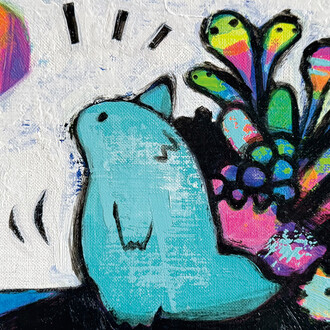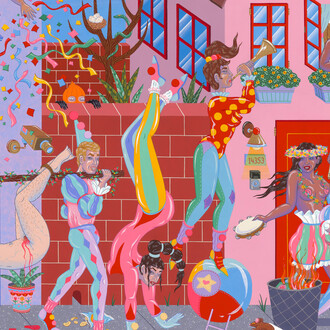Gagosian is pleased to present The painted bride, an exhibition of paintings by Spencer Sweeney opening at the 541 West 24th Street gallery in New York on September 13. Centered on the human figure, Sweeney’s new large-scale works include self-portraits and reclining nudes.
Conveying intense emotion through lively color and expressive paint handling, Sweeney maps the body’s physical and psychological spaces with a combination of enigmatic tone and audacious palette reminiscent of the Surrealists, and of Russian Expressionists such as Alexej von Jawlensky. Allowing faces and encounters to rise from his subconscious to the surface, he employs an “automatic” process that blurs the line between conventional representation and an abstracted charting of the human mind. In the exhibition, this approach is further reflected in an underlying exploration of the unconscious feminine aspect of the masculine mind—the concept of anima first explored in detail by Carl Jung.
In the rear gallery, a set of black charcoal line drawings on unstretched, unprimed linen finds Sweeney portraying himself—in playfully self-deprecating style—adopting a sequence of consciously stilted artist’s model poses. These works resonate with an adjacent canvas in oils and oil stick in which a figure begins to merge with a landscape. Other works on view show figures in repose—some of them also self-portraits—or reinterpret the time-honored motif of the artist in his studio. One painting depicting a band reinforces the inspiration that the artist has drawn from jazz (which is often cited as having influenced his use of improvisation) and other forms of music. (The exhibition is titled The painted bride after a jazz club in Philadelphia, reflecting the venue’s formative influence on Sweeney and his established practice of collaborating with jazz musicians).
Throughout the exhibition, Sweeney also alludes to the history of art through the stylistic vigor of his compositions, in which he amplifies and distorts the vital strides made by William Blake, Édouard Manet, and Beauford Delaney (1901–1979) in staking out and problematizing the boundary between figurative imagery and abstract impression. There are hints, too, of the work of other artists including Francis Picabia and David Hockney. Sweeney combines this immersion in the interplay of tradition and innovation with a restless drive to produce works that are both psychologically direct and revelatory of the creative process. By making use of gestural and textural application alongside a flatter, more graphic approach, and by alternating between intense color and shades of black, white, and gray, he questions the fixity of artistic strategies and styles.
















